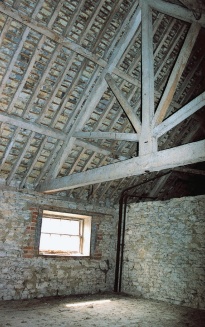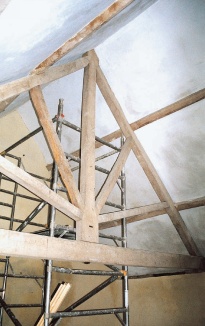The Need for Roofs to Breathe
Richard Oxley
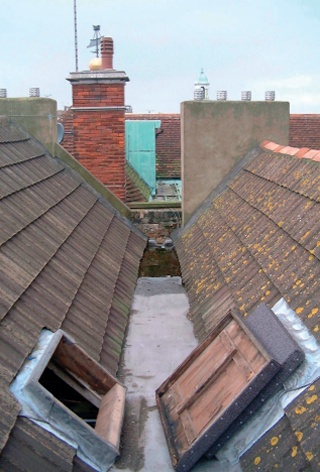 |
|
| Internal valley gutters are a perennial concern as their drainage is vulnerable to blockage by leaves in the autumn and snow in the winter in particular | |
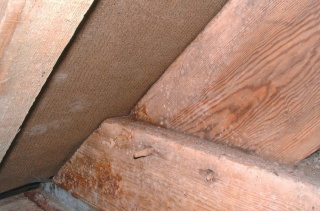 |
|
| Dampness and mould growth on a tie beam caused by the use of impervious roofing felt |
It is now commonly accepted, at least within conservation circles, that it is important not to restrict the ability of traditional building materials and structures to ‘breathe’. However, attention has tended to focus on the damage caused by the use of impervious modern paint systems and cement-rich mortars and renders, and the one part of an old building where the assessment of performance and attention to detail is often neglected is the roof. Yet this is one of the principal areas where ventilation could readily take place, particularly in traditionally detailed tiled or slated roofs.
Today, the performance of many historic roofs has been impaired by the introduction of roofing felts and insulation. Although many roofing felts are now marketed as being vapour permeable, until recently almost all felts were impervious. Roofing felt was introduced primarily to act as a secondary barrier against wind-driven snow and rain, but its use also causes a reduction in air movement within the roof space, particularly if the roofing felt is impervious, and this effect is often compounded by the introduction of insulation. Fibreglass quilt or resin fibre materials, for example, are often laid over eaves and applied to the underside of the roof, in contact with the roofing felt.
In addition, most historic buildings in active use will be subjected to an increase in humidity caused by modern lifestyles. Particular concerns include the production of water vapour due to:
- increased use of the building by the occupants (we now spend more time inside than we used to)
- bathing, particularly showers
- cooking
- water tanks within the roof that are not provided with fitted lids.
Of equal concern is the reduction in natural ventilation caused by:
- the installation of double or secondary glazing
- the reduced use of open fires
- blocking-up disused fireplaces and flues.
BACKGROUND
Traditional variations of a physical secondary barrier against wind-driven snow and rain include reeds laid between the tiles and the battens, and a coating of mortar known as ‘torching’ to the underside of the tiles or slates. Torching is most commonly encountered to the underside of old stone slate roofs. Both techniques allow roofs to breathe.
Roofing felt was first introduced on a regular basis in the 1930s, when it generally comprised of thin building paper. After the Second World War heavy duty bitumen and plastic felts were commonly used, with increasingly impervious materials becoming more common as time went on, until relatively recently when more vapour permeable felts started being introduced.
Insulation started being introduced on a massive scale after the 1970s oil crisis due to the need to make buildings, in particular domestic dwellings, more energy efficient. Insulating our homes is also seen as one of the most effective ways of reducing the demand for fossil fuels, cutting pollution and global warming caused by carbon dioxide.
The lessons that are being learnt from experience of the problems caused by earlier improvements to the energy efficiency of older buildings now need to be heeded, particularly in view of the proposed revision of Part L of the Building Regulations which will increase insulation requirements yet again.
ASSESSING THE PERFORMANCE OF A ROOF
It is important that a holistic approach is adopted for the performance of a building to be understood, as the roof and walls cannot be taken in isolation: they are an integral part of the building and have an active and continuing relationship with the rest of the building, its environment and its occupants.
The two most commonly encountered ways in which the performance of the roof of an old building has been dramatically and detrimentally altered are by the introduction of insulation and impervious roofing felt.
TYPICAL EFFECTS OF INTRODUCING INSULATION AND IMPERVIOUS ROOFING FELT
- The introduction of insulation over a ceiling creates a ‘cold roof’ (see diagram, below).
- Roofing felt significantly reduces the air movement in the roof space.
- Moist air from the accommodation readily finds its way into the roof space through the ceiling and holes in ill-fitting hatches.
- The amount of evaporation that can take place within the roof is considerably reduced by the introduction of the roofing felt.
- Increased amounts of dampness and moist air are now present within the roof space.
- The timbers in the roof space are therefore increasingly subjected to the conditions conducive for active fungal decay and wood boring insect infestation.
- Any drop in the air temperature provides the atmospheric conditions for the condensation of the moist air to take place.
- The impervious roofing felt provides a high level of resistance to the passage of water vapour and a cold contact surface upon which warm moist air can condense. In these circumstances the rafters in contact with the felt may remain damp most of the time, causing the surface of the rafter to become stained and, in the worst case, rotten.
As can be seen, the introduction of both a roofing felt and insulation has provided an environment susceptible to condensation, which in turn increases the risk of dampness and associated timber defects.
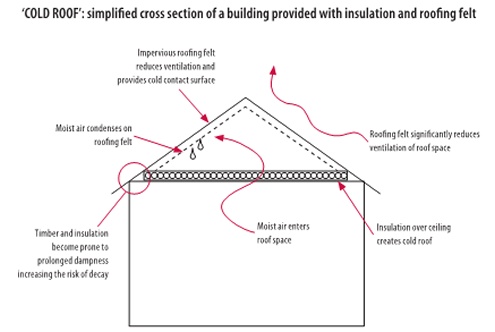 |
TYPICAL INSULATION DEFECTS
- Insulation laid so that it covers the eaves, significantly reduces ventilation to the roof.
- Insulation is often laid in contact with the roofing felt. Where the felt is impervious any contact condensation will run down the felt and make the insulation damp.
- Many modern insulation quilts such as fibreglass, in comparison with alternatives that are now readily available, retain moisture. Where an impervious roofing felt has been used, this type of insulation may not dry out readily. In the worst case the insulation becomes a soggy mass at the bottom, causing the feet of the rafters and the ends of the joists to decay.
This brief overview of some of the problems that can be encountered where the roof of an old building has been provided with a secondary barrier and insulation, illustrates that there is a need to evaluate the influence that any changes in the traditional ‘breathing’ performance of the roofs of old buildings is having.
HOW TO IMPROVE WEATHER-TIGHTNESS AND INSULATION WITHOUT JEOPARDISING THE TRADITIONAL BREATHING PERFORMANCE OF THE ROOF
The options available for improving thermal performance will be largely dictated by the following:
If the building is listed, consent will be required for almost all alteration work, including work to the roof, inside or out, and some restrictions may also apply to external alterations if the building is in a conservation area.
Building Regulations apply if the work involves alterations to an existing building rather than repair. These give some well-defined guidance and measures which may conflict with the needs, requirements and performance of a historic building, particularly after the proposed revision of Part L of the Building Regulations is introduced.
The financial circumstances of the owner may restrict the work which can be carried out. For example, it is far easier to improve the weather-tightness and insulation of the roof of an old building once the existing roof coverings have been carefully removed, but this may not be possible within the budget.
Before making any improvements:
- Ensure that the intervention or loss of historic fabric is kept to an absolute minimum.
- Make sure that the structural performance of the roof will not be adversely affected.
- Be confident that the traditional ‘breathing’ performance of the roof is maintained, or reinstated.
- Take time to carefully select the materials
and methods to be used, to ensure
that they are compatible with traditional
performance requirements - this usually
means that the materials and ‘systems’
need to be vapour permeable.
THE MATERIALS AND METHODS AVAILABLE
Examples of some of the materials that could be used to improve the weather-tightness and insulation of the roof of an old building without jeopardising the traditional ‘breathing’ performance include vapour permeable roofing felt and sheep’s wool insulation. In addition to these two materials, attention should also be given to extracting water vapour at source – particularly in the kitchen and bathrooms. Providing improved ventilation or installing mechanical extractors will significantly reduce the risk of condensation.
VAPOUR PERMEABLE ROOFING FELT
One technical advance made in recent times is the production of a roofing felt which allows some movement of water vapour through it. This is a vast improvement on some of the impervious felts previously used.
However, it is important to appreciate that these new roofing felts have not been tried and tested over any significant period of time. Although designed and promoted as being vapour permeable, a roofing felt is a compromise that both allows the movement of water vapour and, by providing a secondary barrier, significantly reduces the risk of water penetration (which is most important when regular inspection and maintenance is not standard practice).
The provision of a properly detailed roofing felt requires the roof coverings to be stripped, so it may need to be delayed until the condition of the roof justifies stripping it, or the opportunity arises for this work to be carried out.
As can be seen, great care is needed when introducing any barriers to historic buildings to prevent any restriction in the movement and evaporation of water vapour. It is essential that the positioning and detailing of any vapour barrier is correct, and on the warm side of the insulation, otherwise water vapour may be trapped against timbers, ceilings or insulation and causing problems for the building.
The reluctance to carry out regular
inspection and maintenance has lead to an
increased reliance on the use of vapour barriers
and roofing felts. It is preferable to carry out
regular maintenance wherever possible, rather
than change the performance of a historic
building, bearing in mind that the building
has performed well and survived, in some
cases, for centuries without these barriers. Where
the decision is made that a roofing felt is to be
introduced it needs to be ensured that it is of
an appropriate type and correctly detailed.
SHEEP'S WOOL INSULATION
The insulation material that has probably received the most publicity recently is sheep’s wool. The benefits of this material are:
- it is mainly natural (although resin fibres have to be added for bonding and where some rigidity is required)
- it is a ‘breathable’ material as it is porous and hygroscopic – yet it still retains its thermal insulation capabilities when damp
- it is not an irritant to those who use the material.
Sheep’s wool is derived from renewable
resources and has a relatively low embodied
energy. It therefore has environmental
advantages over many other conventional
alternatives. These factors, together with
‘life cycle costings’, should be an important
consideration when assessing what materials
to use in the repair and improvement of all
buildings, not just historic buildings.
CASE STUDY |
|
The roof before works implemented and, below, nearing completion
|
The question of how best to insulate and ventilate a historic roof cannot be answered with a single solution; different situations require different solutions. Each building should be considered individually and holistically. This case study shows how one particular set of problems was addressed. In this case the roof coverings, which consisted of stone slate to one slope and concrete tiles to the other, were to be left intact. The brief was to provide a finish suitable to accommodate the conversion of an unused upper floor ‘loft’ space and improve the thermal insulation. The factors to be taken into consideration included the absence of roofing felt, and the building's location in an exposed situation where there was a strong risk of wind-blown snow and rain penetrating the roof space. There was a risk that water penetration could occur in sufficient quantities to cause staining and discolouring of the ceilings or even timber decay. In this case, lime mortar torching to the underside of the roof coverings was used in the vernacular tradition to reduce the risk of wind-blown snow or rain. The subsequent risk of water penetration caused by loose or dislodged slates or tiles causing the torching to break down was mitigated by the use of a lightweight vapour permeable building paper to the underside of the rafters. The building paper also acts as a means of reducing draughts, which improved the effectiveness of the insulation. The disadvantage of this detail is that any water that penetrates the roof coverings could run down the paper and collect at the wallplate. For this reason the client was made aware of the need for regular inspections and maintenance. Insulation was provided between the rafters with natural wool insulation and a lightweight mineral wool insulation board was used to provide a face upon which to apply two coats of lime plaster, which was subsequently limewashed. (An alternative to the lightweight mineral wool insulation board is the use of reed board, which is composed of natural water reed held together with wire.) The benefit of using a natural insulation material in this manner is that the permeability of the building’s envelope is maximised while allowing the upper floor accommodation to be used to its full potential. Although some of the materials were relatively new, they were already commonly used and readily available. These and other similar materials provide the best compromise where the thermal insulation of a building needs to be improved while maximising permeability and thereby reducing the risks of condensation and any associated problems. Not only is this in the best interests of the building, but the improvement of the thermal performance is also in the best interests of the environment – provided that careful thought has gone into the environmental impact and sustainability of the materials selected. |
BATS AND BIRDS It is not uncommon to find that bats use a roof space. Bats do not pose a significant threat to the building fabric or the health of the occupants and, under Section 9 of the Wildlife and Countryside Act (1981), it is an offence to intentionally damage, destroy or obstruct access to any place used by bats, even when bats are apparently absent, or to disturb bats while roosting, just as it is an offence to intentionally kill, injure or take a bat. Where bats are present or there is evidence that bats have used, or are using a roof, Natural England or a local bat group should be contacted for informed advice and guidance before any roofing works are programmed and initiated. If there is an active bat roost, works will need to be programmed to cause the minimal amount of disturbance and measures provided to allow bats to continue to use the roof space upon completion of the roofing works. It also needs to be appreciated that the Wildlife and Countryside Act 1981 gives protection, with certain exceptions, to all birds, their nests and eggs. It is an offence to:
Consequently, roofing works need to be specifically programmed where nesting birds are present so that any disturbance is minimised to reduce the risk of the birds deserting their nests or young. |
~~~



